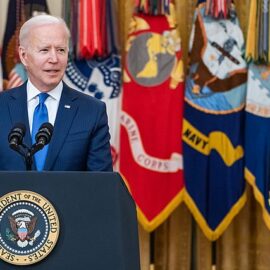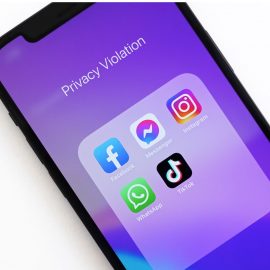

This article is an excerpt from the Shortform book guide to "Barbarians at the Gate" by Bryan Burrough and John Helyar. Shortform has the world's best summaries and analyses of books you should be reading.
Like this article? Sign up for a free trial here.
Do people usually bid on companies in LBOs? How many financial companies bid on RJR Nabisco?
According to Barbarians at the Gate by Bryan Burrough and John Helyar, competitive bidding is unusual in LBOs. But because Ross Johnson pitched the idea of an LBO to his board before preparation, it become a bidding contest between different competitors.
Continue reading to learn more about the bidding contest for RJR Nabisco.
The Bidding Contest for RJR Nabisco
As Burrough and Helyar explain, usually people doing an LBO will carefully determine what the company is worth, estimate how much debt it can pay down, and secure funding commitments from banks before proposing the LBO to the board of directors. This makes it almost impossible for anyone else who might be interested in buying the company to come up with a viable counteroffer before the board reaches a decision.
However, Ross Johnson’s team didn’t do that, leading to a competitive company bidding. Instead, Johnson pitched the idea of an LBO to the board very early in the process, presenting it as a solution to the problem of their low stock price, and asking for their approval to move forward. He did this because he wanted to maintain his good relationship with the board, whether they approved the LBO or not. Besides this, Shearson didn’t think anyone else would be interested in buying the company anyway, given the lagging stock price and the public sentiment against tobacco companies.
| Loss Aversion Bias In Thinking Fast and Slow, Nobel laureate Daniel Kahneman discusses biases in human thinking and how these natural biases can lead us to make irrational business decisions. Ross Johnson’s approach to the RJR Nabisco LBO appears to have been influenced by loss-aversion bias, which Kahneman explains as part of the “prospect theory” of how humans evaluate possible gain and loss. According to prospect theory, you tend to focus on changes to your situation, not on expected end states, and you tend to see losses as more significant than gains. So, if you start with $1 million and end up with $2 million after a business venture, you’ll be elated because you gained $1 million, but if you start out with $4 million and end up with $2 million after a business venture, you’ll feel terrible because you lost $2 million, even though your net worth after the venture is the same in both cases. Loss aversion bias arguably influenced Ross Johnson in three ways: He may have been driven to pursue the LBO because he viewed stagnation (of the stock price, the corporate structure, and so on) as a type of loss, and thus felt he had to do something to avoid the loss. He accepted the idea of an LBO only in an unusually generous partnership with the financial firm that would handle it because he didn’t want to lose influence and perks in the company. He approached the board unusually early in the LBO process because he didn’t want to lose his influence with the board in the event they disapproved of the LBO. |
Competitors Emerge
Burrough and Helyar recount how the assumption that no one else would try to buy RJR Nabisco proved to be horribly wrong. When the board gave Johnson the go-ahead to pursue an LBO, he and Shearson proposed to pay $75 per share based on their initial analysis. This was published in a press release. A number of financial companies saw the press release and thought RJR Nabisco was worth a lot more than $75 per share.
Kravis
The Kohlberg Kravis company was a financial consulting firm that, according to Burrough and Helyar, had arguably invented LBOs and was unarguably the market leader in LBO consulting. They were among the first to react to the press release. After meeting with banks to discuss the value of RJR Nabisco and the availability of funding, they considered offering the board $90 per share.
Burrough and Helyar note that before Kravis reached a decision on how much to offer per share, someone leaked their meeting minutes to the press, and a newspaper ran a story announcing that they were offering $90 per share for RJR Nabisco. Upon seeing the story, Kravis felt obligated to make the offer official in order to avoid confusion or bad press.
Kravis was at a severe disadvantage when it came to determining how much RJR Nabisco was worth because no one at Kravis had inside knowledge of RJR Nabisco’s operations. This was in contrast to practically all the other LBOs they had done, where they worked closely with the company’s executives. Shearson and Kravis considered partnering up instead of bidding against each other but were unable to agree on the terms of the partnership.
Salomon
Burrough and Helyar report that a finance company called Salomon Brothers also prepared to make an offer to buy RJR-Nabisco when they saw the press release stating that Shearson had offered $75 per share. When they saw Kravis’s competing bid of $90 per share, they backed off.
After the partnership negotiations between Kravis and Shearson broke down, Shearson started looking for other partners to augment their financial resources for competitive bidding. At that point, Salomon entered into a partnership with Shearson. With Salomon’s backing, Shearson increased their offer from $75 per share to $92 per share.
Forstmann
Forstmann Little, the second-leading LBO company after Kravis, was also interested in owning RJR Nabisco. Shearson and Salomon offered to partner with Forstmann, but after reviewing their financial analysis and proposal in detail, Forstmann declined.
According to Burrough and Helyar, Forstmann thought Shearson’s fees were excessive and their analysis wasn’t very good. Also, unlike most other LBO consultants, Forstmann eschewed junk bonds and thus objected to taking on partners who would sell junk bonds to raise money for the LBO.
Forstmann later partnered with Goldman Sachs, and they prepared to put in their own bid. But after doing their financial analysis, they decided they couldn’t safely bid more than $85 to $90 per share without resorting to junk bonds. Since they couldn’t top the highest bid that had already been placed, they withdrew from the contest without making a formal bid.
First Boston
As Burrough and Helyar recount, the final interested party was the First Boston financial consulting firm. First Boston had been a market leader in mergers and hostile takeovers, until two of their executives and a number of their employees left to form a competing company.
They were still struggling to recover from the split when the RJR Nabisco LBO was announced, and they wanted to participate in the LBO mostly to save face: Since the RJR LBO was the largest LBO in history, and since it seemed like every other major financial firm on Wall Street was getting involved in one way or another, sitting on the sidelines would have made it look like the corporate schism had completely ruined them.
Burrough and Helyar note that First Boston got a late start assessing RJR Nabisco’s value, but found a clever way to save about $4 billion by taking advantage of an obscure financial mechanism to defer some taxes.
Formal Bidding
According to Burrough and Helyar, when RJR Nabisco’s board began receiving competitive offers for the company, they announced a formal bidding deadline of 5 p.m., November 18, 1988. By this deadline, Ross Johnson’s management team, supported by Shearson and Salomon, submitted a final bid of $100 per share. Kravis, still without access to inside information about the company, bid a more cautious $94 per share.
First Boston was unable to finish their analysis, much less secure financial backing of major banks by the deadline, but they submitted a preliminary proposal outlining how they hoped to offer between $105 and $118 per share. Since First Boston’s bid appeared to be the highest but was incomplete, the board voted to reject all the bids and announced a new deadline that would give First Boston a little over a week to finish their analysis and secure financial backing.
The Second Round
Burrough and Helyar describe how Kravis spread a rumor that they might not bid in the second round, or wouldn’t raise their bid much if they did. But during this time, Kravis also finally found an RJR Nabisco executive who was willing to discuss its operations, especially avoidable expenses that the company could eliminate to improve profitability. Based on this new information, Kravis ended up bidding $106 per share in the second round.
Meanwhile, Johnson’s team bid $101 per share, not expecting much competition: They didn’t think First Boston would be able to pull off what they had proposed, and they more or less believed the rumor that Kravis wouldn’t bid again. They were wrong about Kravis, but they were right about First Boston. Although First Boston finished much of their analysis, they were unable to secure enough financial backing to convince the board that their bid was a viable option.
The Third Round
According to Burrough and Helyar, Johnson’s financial consultants were surprised and outraged by Kravis’s high bid. Furthermore, upon analyzing Kravis’s bid, they realized that it employed less cash and more junk bonds than their own bid. Reworking their bid along the same lines, they determined that they could bid at least $108 per share. They demanded that the board extend the bidding again.
When the board ignored them because they were already working with Kravis to finalize details of the buyout, Shearson and Salomon issued a press release stating that they had increased their bid to $108. Once Shearson’s bid was published, the board felt they couldn’t ignore it. They paid Kravis $45 million in consulting fees for the work they’d already done on the details and reopened bidding.
Johnson, backed by Shearson and Salomon, made a final bid of $112 per share, while Kravis made a final bid of $109 per share. However, the board’s financial advisers determined that the real value of both bids was about the same because Shearson’s junk bonds carried a higher risk than Kravis’s junk bonds. Regarding the two bids as equal, the board voted to sell the company to Kravis.
Burrough and Helyar conjecture that the board chose Kravis partly because they had already started working with them after the previous bid, and partly because their sentiments had shifted against Johnson during the LBO process. Both LBOs in general and Ross Johnson’s proposed LBO in particular had drawn a lot of negative press. Many commentators argued that LBOs were motivated by executives’ greed and resulted in irresponsible levels of corporate debt. In particular, when the press found out about the exceptionally generous terms of Johnson’s partnership with Shearson, they portrayed Johnson as the epitome of corporate greed.
The Aftermath
Burrough and Helyar report that Ross Johnson accepted the loss of the bidding contest graciously and went into retirement. He asserted that both his actions in initiating the LBO and the ultimate outcome had been best for the company’s stockholders. Some of the stockholders, though, disagreed: RJR Nabisco stock had paid dividends, and the company was so profitable that stockholders were making money even when the stock price was low. So they were sorry to lose their stock even though they got a big payout when the company sold.
Kravis hired a new management team to run RJR Nabisco, restructured the company, and eventually sold it again. In the end, Kravis made only a small profit on the LBO, despite streamlining RJR Nabisco’s operations to increase the company’s profitability by almost 50%.
After the RJR Nabisco LBO, leveraged buyouts became much less popular. Burrough and Helyar believe this was due in large part to the negative publicity that LBOs and especially junk bonds received, which reached a peak during the RJR Nabisco buyout. Of the few LBOs that did happen after 1988, most were handled by Forstmann Little without using junk bonds.

———End of Preview———
Like what you just read? Read the rest of the world's best book summary and analysis of Bryan Burrough and John Helyar's "Barbarians at the Gate" at Shortform.
Here's what you'll find in our full Barbarians at the Gate summary:
- The history of the RJR Nabisco buyout that caused drama and intrigue
- Inside information on many of the people and companies involved
- How leveraged buyouts and junk bonds work






